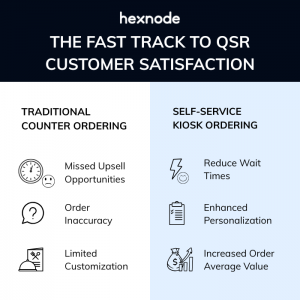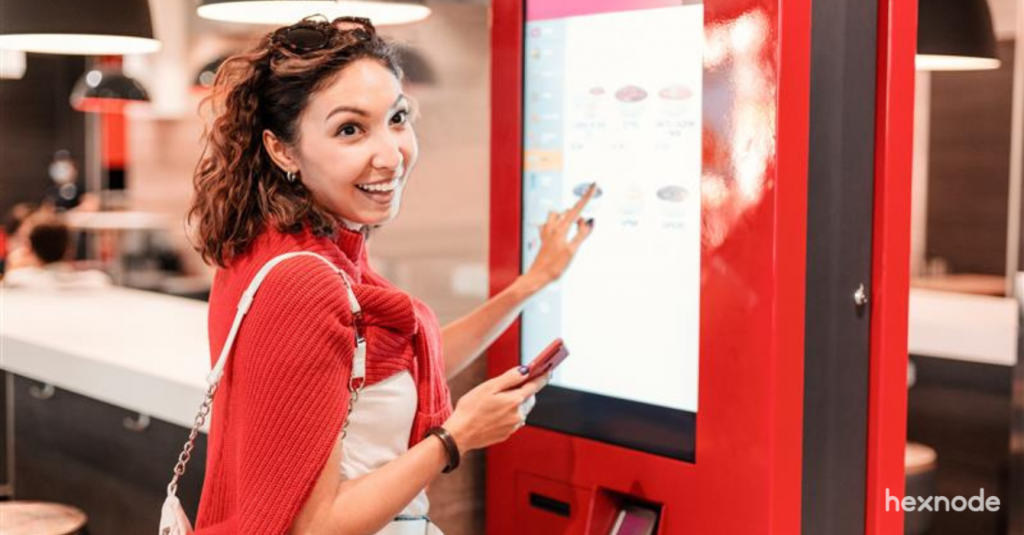Self-service kiosks for restaurants are simply interactive touchscreens that let customers order and pay for their food all by themselves. They talk directly to the kitchen and the cash register (POS system), making the service much faster. This isn’t just a cool new tool anymore; it’s a must-have asset for QSRs looking to keep pace with modern customer expectations.
People these days expect things to be quick, their orders to be 100% accurate, and they want to personalize their meal exactly how they like it. The old way—ordering at a busy counter under pressure—often falls short. Wasting even a minute in line or waiting for a mistaken order to be fixed creates frustration, which can make customers go somewhere else.
This is where the self-service kiosk changes everything. It gives control back to the customer. They can take their time looking at the menu, easily customize ingredients without feeling rushed, and confirm the total cost privately. This freedom removes the stress of ordering quickly—the so-called “line anxiety.” The results are clear:
While the benefits on the front end are clear, remember that rolling out a bunch of kiosks isn’t as simple as plugging them in. These devices are very important—if one goes down, you’re not just losing service speed; you’re losing sales. Therefore, they must always be perfectly secure and 100% reliable. This management complexity is why a strong Unified Endpoint Management (UEM) platform like Hexnode is necessary. It’s the engine behind the scenes that helps businesses manage and maintain their entire fleet of important kiosks easily and securely.
- Why Self-Service Kiosks Are Game-Changers for QSRs
- Faster Service and Reduced Wait Times
- Order Accuracy and Reduced Human Error
- Improved Operational Efficiency
- Improving Customer Experience Through Personalization
- Higher Average Order Value (AOV)
- Better Data Analytics & Decision-Making
- Cost Savings and Workforce Optimization
- Managing and Securing Kiosks in QSR Environments
- Device Lockdown and Anti-Tampering
- Ensuring Secure Transactions
- Real-Time Menu Updates
- Future of Self-Service in QSRs
- FAQs
Why Self-Service Kiosks Are Game-Changers for QSRs
Self-service kiosks are completely changing the way fast-food restaurants operate. They directly solve the biggest problems customers face today: long lines and mistaken orders. By letting customers take control of their experience, these simple touchscreens instantly make service faster, boost order accuracy, and even help restaurants make more money—all at the same time.
Faster Service and Reduced Wait Times
The old counter model forces everyone into a single, slow line congested by one or two cashiers. Kiosks break this model by creating multiple ways to order at once.
Instead of serving just one customer, you can now handle five, six, or even ten people simultaneously. This is a game-changer during the busiest times, like lunch and dinner. You typically multiply your ability to take orders, which dramatically speeds up the whole operation.
However, this benefit only works if the kiosks are actually running. From a management perspective, this requires proactive health checks. A “Closed” sign on a screen is just as bad as a long queue. By using remote monitoring tools like Hexnode, IT teams can check the devices’ health in real-time—including connectivity, app status, and attached hardware—to ensure 99%+ kiosk uptime and prevent service from grinding to a halt.
Order Accuracy and Reduced Human Error
Mistakes in orders are a major cause of customer frustration, wasted food, and lost money. A kiosk eliminates miscommunication between staff and customers by having the customer enter the order themselves.
They see exactly what they’re ordering on a large screen. They review their own changes and confirm the final order before it goes through. This digital order then goes straight to the cash register (POS) and the kitchen screen system (KDS) without any human translating it, removing the risk of error during busy periods.
Here’s a practical example for operators: What if you suddenly run out of avocados? A customer ordering a “sold out” item is highly frustrating. Instead of taping temporary paper signs on every screen, a platform like Hexnode allows you to instantly update the menu’s digital content or app configuration across your entire fleet, making sure the menu is accurate right now.
Improved Operational Efficiency
When kiosks handle the repetitive work of taking orders and processing payments, your team is free to focus on what matters most: making food faster, checking quality, and offering a welcoming presence to customers.
The kiosk also serves as a perfect, consistent salesperson. It never forgets to ask, “Would you like to make that a combo?” or suggest a profitable dessert. Finally, every touch on that screen is a piece of data, giving you detailed insights into what people are ordering and what’s popular, which lets management make smart, data-driven decisions.
Improving Customer Experience Through Personalization
While making the customer happy is the main goal, fast-food operators find that the smart business benefits of kiosks are just as convincing. These are more than just service tools; they are important for making money and gathering useful information.
Higher Average Order Value (AOV)
A kiosk is your most reliable and effective salesperson. Unlike a cashier who might be stressed during a rush, a kiosk never forgets to offer an upsell. It’s programmed to strategically suggest high-profit add-ons, combo upgrades, and dessert options at the best moment.
This whole process is also low-pressure for the customer. They don’t feel judged or rushed, which makes them more likely to “treat themselves.” When you combine this with a clear, visually appealing menu, these automated suggestions work incredibly well. A nice picture of a “double patty” or “extra bacon” drives impulse buys much more reliable than just asking a customer verbally, directly boosting the Average Order Value.
Better Data Analytics & Decision-Making
Every time a customer uses your kiosk, it creates a data point. When you put all this information together, it gives you a detailed, real-time understanding of your business that is much better than simple sales reports.
You can analyze which menu items are most popular at specific times of the day, how long customers look at customization screens, and which upsell prompts lead to the most purchases. This data is priceless. It lets you fine-tune your menu, set better prices, and predict inventory needs with much greater accuracy. You’re no longer guessing what customers want; you’re making smart, strategic decisions based on solid proof. This leads to smarter marketing and more efficient stock management.
Cost Savings and Workforce Optimization
This is often the most immediate benefit for daily operations. Kiosks automate the time-consuming tasks of taking orders and processing payments. This means you need fewer cashiers at the front counter.
However, the goal isn’t just to cut costs; it’s smarter staffing. By automating the transaction, you free up your human team to focus on the relation. Those team members can now be moved to crucial areas that directly improve customer experience—speeding orders from the kitchen, keeping the dining area clean, or acting as friendly hosts who can help guests and solve problems.

Managing and Securing Kiosks in QSR Environments
Leaving a kiosk completely unmanaged is simply not an option. It puts your whole network at risk, leads to a terrible experience for customers when it breaks, and turns a helpful tool into a major problem. This is exactly where a strong Unified Endpoint Management (UEM) platform like Hexnode shows its true value: it takes a regular tablet and makes it a secure, reliable, and remotely controlled tool for your fast-food business.
Device Lockdown and Anti-Tampering
You definitely don’t want a customer leaving your ordering app to surf the web or, even worse, messing with the device settings. Our first and main security step is Hexnode’s Single-App Kiosk Mode. This setting is pushed remotely and does a few key things:
- It completely hides the underlying operating system’s navigation.
- It locks the device to only run the POS/ordering application.
- It disables all hardware buttons and access to settings.
The tablet is no longer just a tablet; it becomes a dedicated machine for taking orders. This stops all customer tampering and makes sure the device is always ready for the next person.
Ensuring Secure Transactions
Since these kiosks handle credit card payments, they are a big target for hackers and must follow the strict PCI DSS security standards. A security breach here would be disastrous.
Hexnode UEM acts as your security guard, allowing your IT team to remotely and automatically force OS updates and critical security patches across every single kiosk. We make sure that device-level encryption is always turned on, and that network settings are completely locked down. To protect your restaurant’s sensitive payment data and ensure you follow all compliance rules, you can explore how Hexnode enforces Zero Trust security on all payment terminals.
Your menu is always changing. When you run out of an ingredient or launch a new special deal, that change needs to happen instantly and everywhere. If your kiosks aren’t managed, this is impossible.
With Hexnode, you can remotely push a new application to update or deploy new content files (like updated prices or “Sold Out” graphics) to every single kiosk in your entire chain at the same time. This remote content deployment stops customers from getting frustrated by inaccurate menus and guarantees that promotions go live at the perfect moment.
Future of Self-Service in QSRs
Today’s self-service kiosk is just the foundation for what’s next. The next big step is the “intelligent endpoint.” We are quickly moving toward a future driven by AI-powered personalization. The next big step is the “intelligent endpoint.” We are quickly moving toward a future driven by AI-powered personalization.
Imagine a kiosk that recognizes a loyal customer through their phone app, greets them by name, and not only suggests their “usual” order but also recommends a brand-new item based on what they’ve liked before.
This change will be sped up by new technology like AI voice ordering, which removes the need to touch the screen and makes ordering even quicker. Behind the scenes, these devices will need more complicated connections to customer and loyalty systems (CRM) to make this personalization work. At the same time, there is a big move toward using sustainable hardware—devices that use less energy and are made from recycled materials.
But this advanced future brings big management problems. A kiosk running a complex AI model and deep CRM integrations is much harder to secure and manage than a simple, locked-down tablet.
This is why a management plan that can grow along with your business is important. A future-proof UEM like Hexnode is built for this evolution. Our platform offers a flexible framework that can work with any operating system (OS-agnostic) that fast-food chains need to manage this varied fleet. Whether it’s pushing a critical security update to a new OS, remotely updating a voice-recognition app, or securing the data from a new loyalty system, Hexnode ensures you can innovate with confidence, knowing every device is secure, compliant, and under control.

FAQs
How do self-service kiosks enhance customer experience in restaurants?
They reduce wait times, ensure order accuracy, and enable personalization. Customers enjoy faster, more convenient service while restaurants gain efficiency and higher order values.
Are self-service kiosks secure for handling customer payments?
Yes. Managed through UEM platforms like Hexnode, kiosks can enforce strict app restrictions, encryption, and secure payment gateways to ensure data protection and compliance.
How are self-service kiosks changing customer behavior?
Self-service kiosks empower customers to control their ordering experience — they explore menus longer, customize meals, and spend more per order. This autonomy fosters satisfaction, repeat visits, and brand loyalty while freeing staff to focus on service quality.
Want to increase your QSR sales?
Transform your QSR operations with secure, efficient self-service kiosks. Manage every device remotely with Hexnode UEM—Start your free trial today!
Signup now!




